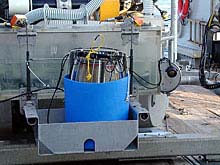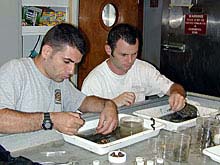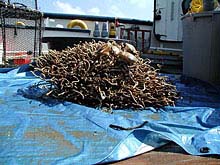
This is the “Bushmaster Junior” collection device in its holster on the front of the sub prior to launch. Click image for a larger view.
October 9, 2002
Erik Cordes
Pennsylvania State University
On yesterday morning’s dive, Johanna Jarnegren and Stephane Hourdez collected a tubeworm bush from one of the Mississippi Canyon sites where we had never collected an entire bush before. We collect them with a net-like device of our own design, which we call the “Bushmaster.” The one we are using on this cruise, “Bushmaster Junior,” is the smaller of the two Bushmasters. During a collection, the net is lowered over the top of a tubeworm bush with the mechanical arm of the submersible. A metal cable on the bottom is then cinched closed, collecting the tubeworm bush and all of the animals inside. The fine-meshed net of the Bushmaster is placed into a small container that is also lined with a net so we don’t lose anything on the way to the surface.
Once it reaches the deck of the ship, we place the collection into a large tub and carefully remove all of the organisms captured along with the tubeworms. Once these other animals are removed, the bush is taken out of the tub and wrapped in plastic. We preserve the aggregation and bring it back to Penn State where we measure and weigh each of the individual tubeworms in the bush. By collecting bushes from different sites, we can see how the communities associated are different among Gulf of Mexico seep sites.

Stephane and Erik sorting the animals from the tubeworm bush. They separated the collection into all of the species that they could easily identify on board. In this rough sorting, they identified more than 30 different species associated with this one collection. Click image for a larger view.
Sign up for the Ocean Explorer E-mail Update List.

























